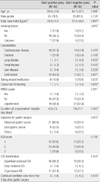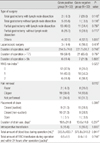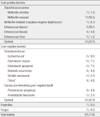1. Kim JM, Park ES, Jeong JS, Kim KM, Kim JM, Oh HS, Yoon SW, Chang HS, Chang KH, Lee SI, Lee MS, Song JH, Kang MW, Park SC, Choe KW, Pai CH. Nosocomial Infection Surveillance Committee of the Korean Society for Nosocomial Infection Control. Multicenter surveillance study for nosocomial infections in major hospitals in Korea. Am J Infect Control. 2000. 28:454–458.

2. Mangram AJ, Horan TC, Pearson ML, Silver LC, Jarvis WR. Hospital Infection Control Practices Advisory Committee. Guideline for prevention of surgical site infection, 1999. Infect Control Hosp Epidemiol. 1999. 20:250–278. quiz 279-80.

3. Alexander JW, Solomkin JS, Edwards MJ. Updated recommendations for control of surgical site infections. Ann Surg. 2011. 253:1082–1093.
4. Cheadle WG. Risk factors for surgical site infection. Surg Infect (Larchmt). 2006. 7:Suppl 1. S7–S11.
5. Ho VP, Stein SL, Trencheva K, Barie PS, Milsom JW, Lee SW, Sonoda T. Differing risk factors for incisional and organ/space surgical site infections following abdominal colorectal surgery. Dis Colon Rectum. 2011. 54:818–825.
6. Owens CD, Stoessel K. Surgical site infections: epidemiology, microbiology and prevention. J Hosp Infect. 2008. 70:Suppl 2. 3–10.
7. Anderson DJ, Chen LF, Sexton DJ, Kaye KS. Complex surgical site infections and the devilish details of risk adjustment: important implications for public reporting. Infect Control Hosp Epidemiol. 2008. 29:941–946.
8. Malone DL, Genuit T, Tracy JK, Gannon C, Napolitano LM. Surgical site infections: reanalysis of risk factors. J Surg Res. 2002. 103:89–95.
9. Nichols RL, Webb WR, Jones JW, Smith JW, LoCicero J 3rd. Efficacy of antibiotic prophylaxis in high risk gastroduodenal operations. Am J Surg. 1982. 143:94–98.

10. Sjöstedt S, Levin P, Malmborg AS, Bergman U, Kager L. Septic complications in relation to factors influencing the gastric microflora in patients undergoing gastric surgery. J Hosp Infect. 1989. 13:191–197.

11. Watanabe A, Kohnoe S, Shimabukuro R, Yamanaka T, Iso Y, Baba H, Higashi H, Orita H, Emi Y, Takahashi I, Korenaga D, Maehara Y. Risk factors associated with surgical site infection in upper and lower gastrointestinal surgery. Surg Today. 2008. 38:404–412.

12. Lee S, Kim S, Lee J, Lee K. Risk factors for surgical site infection among patients in a general hospital. Korean J Nosocomial Infect Control. 2007. 12:9–20.

13. Kim YK, Kim HY, Kim ES, Kim HB, Uh Y, Jung SY, Jin HY, Cho YK, Kim EC, Lee YS, Oh HB. The Korean surgical site infection surveillance system report, 2009. Korean J Nosocomial Infect Control. 2010. 15:1–13.
14. Kim ES, Chang YJ, Park YS, Kang JH, Park SY, Kim JY, Lee SE, Kim SH, Kwon SH, Choi YH, Jin HY, Kim HY, Uh Y, Kim BH, Son HJ, Choi HJ. Multicenter surgical site infections surveillance system report, 2007: In total hip and total knee arthroplasties and gastrectomies. Korean J Nosocomial Infect Control. 2008. 13:32–41.
15. Horan TC, Andrus M, Dudeck MA. CDC/NHSN surveillance definition of health care-associated infection and criteria for specific types of infections in the acute care setting. Am J Infect Control. 2008. 36:309–332.

16. Horan TC, Gaynes RP, Martone WJ, Jarvis WR, Emori TG. CDC definitions of nosocomial surgical site infections, 1992: a modification of CDC definitions of surgical wound infections. Am J Infect Control. 1992. 20:271–274.

17. Owens WD, Felts JA, Spitznagel EL Jr. ASA physical status classifications: a study of consistency of ratings. Anesthesiology. 1978. 49:239–243.

18. Culver DH, Horan TC, Gaynes RP, Martone WJ, Jarvis WR, Emori TG, Banerjee SN, Edwards JR, Tolson JS, Henderson TS, et al. National Nosocomial Infections Surveillance System. Surgical wound infection rates by wound class, operative procedure, and patient risk index. Am J Med. 1991. 91:152S–157S.

19. Enzler MJ, Berbari E, Osmon DR. Antimicrobial prophylaxis in adults. Mayo Clin Proc. 2011. 86:686–701.

20. Kang J, Sickbert-Bennett EE, Brown VM, Weber DJ, Rutala WA. Relative frequency of health care-associated pathogens by infection site at a university hospital from 1980 to 2008. Am J Infect Control. 2011. (in press).







 PDF
PDF ePub
ePub Citation
Citation Print
Print





 XML Download
XML Download